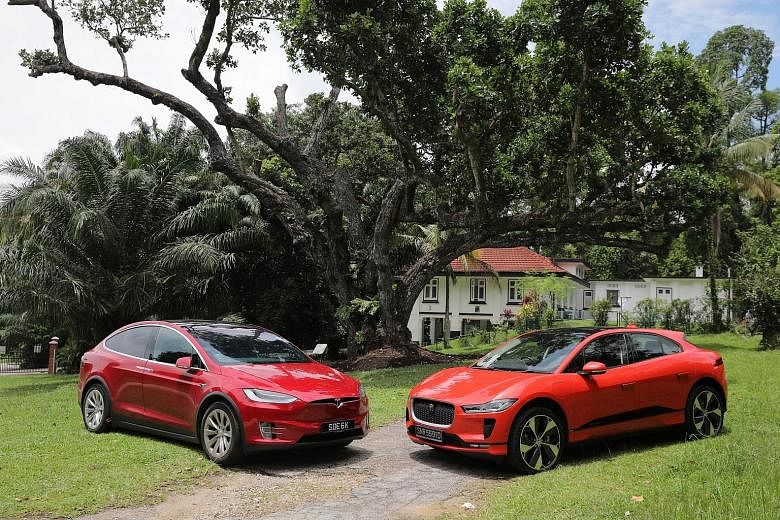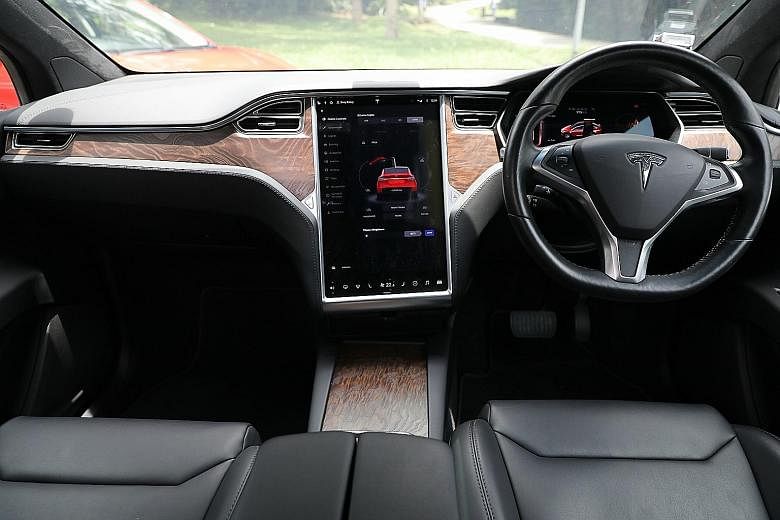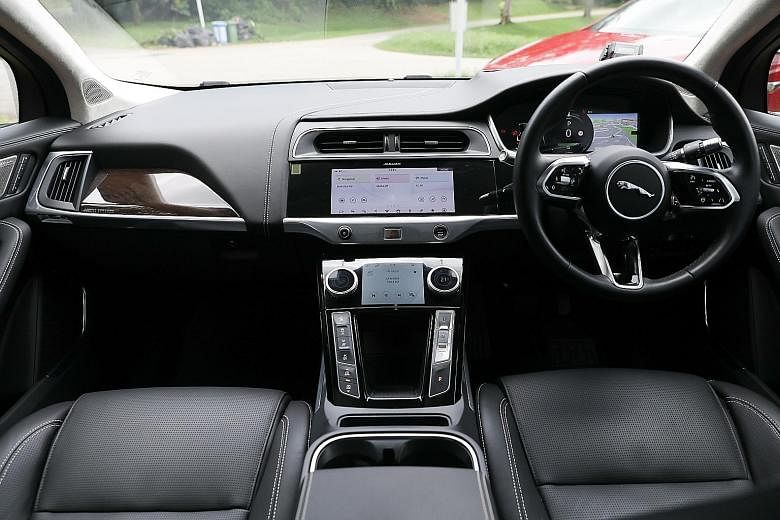Slowly but surely, electric vehicles (EVs) are populating Singapore's roads. Their presence is welcome as their benefits include zero local emissions, low noise pollution, lower operating costs and higher reliability because they have simpler powertrains.
Here, we compare two cars which bookend the electric sport utility vehicle (e-SUV) spectrum - the Jaguar I-Pace (the reigning Straits Times Car of the Year) and, from the brand that is synonymous with EVs, the Tesla Model X.
They are not direct rivals. Parked side by side, the huge Model X makes the I-Pace look pert. The Tesla seats up to seven passengers and the Jaguar, five. There is also the small matter of the Tesla costing well more than $100,000 more.
Apart from how these two cars stack up against each other, it is also interesting to see how they individually address their quite distinct remits.
The I-Pace we already know and love. Its avant-garde looks and coupe-like roofline make it the coolest-looking crossover around and hint at the delicious driving experience it delivers.
If the I-Pace is the lithe athlete of e-SUVs, the Model X is the burly weightlifter. It is more than 30cm longer and 10cm wider than the I-Pace and at more than 2.3 tonnes, it is also heftier.
And while its sheer size gives the clean, pebble-shaped body ample presence, its looks are less head-turning than the Jaguar's.
The Tesla's party piece is, of course, its fabled rear falcon-wing doors, which soar majestically at the touch of a button. They are show-stopping and brilliantly conceived. Being double-hinged, they need less lateral space than conventional doors, making them perfect for Singapore's narrow carpark lots.
They also open with a much wider and taller aperture, making entry into the second-and third-row seats a doddle. No fear of them hitting a car parked alongside or a low carpark ceiling. There are multiple sensors to detect obstacles, so the doors will go only as far as they are able to.
Unsurprisingly, the Tesla's cabin is vast, even rivalling that of large MPVs (multi-purpose vehicles). Legroom in the back is limousine-like, and even the optional third row of seats has ample space for tall adults.
Materials and build are a step behind the Jaguar's, though. When it comes to ambience, Tesla still has things to learn from the luxury marques.
-
JAGUAR I-PACE
-
PRICE $378,999 with COE
MOTOR Twin transverse permanent-magnet synchronous; 90kWh lithium-ion battery
TRANSMISSION Single-stage epicyclic reduction
POWER 400hp
TORQUE 696Nm
0-100KMH 4.8 seconds
TOP SPEED 200kmh
CONSUMPTION 24.8kWh/100km
AGENT Wearnes Automotive
RATING 8.5/10 (Shreejit); 8.5/10 (Edric)
In keeping with the company's techy image, the Tesla's cockpit is resolutely minimalist. While the I-Pace's centre console retains physical dials and buttons for air-conditioning, volume and some minor controls, the one in the Model X has only an immense 17-inch portrait-style touchscreen, on which you can not only access the full suite of settings and ancillary controls, but also operate the doors and tailgate, adjust the ride height, surf the Net and even use as a sketchpad.
-
TESLA MODEL X P75D
-
PRICE $516,000 with COE
MOTOR Twin transverse permanent magnet induction; 75kWh lithium-ion battery
TRANSMISSION Single-stage reduction
POWER 518hp
TORQUE 658Nm
0-100KMH 5.2 seconds
TOP SPEED 210kmh
CONSUMPTION 20.8kWh/100km
AGENT Hong Seh Motors
RATING 7/10 (Shreejit); 7.5/10 (Edric)
Just like your mobile phone, the Tesla can receive over-the-air software updates, so it can be upgraded with new features and capabilities as they are released.
Underneath, these cars have some striking similarities as well as subtle but distinctive differences.
For a start, their powertrains are built around twin transversely mounted electric motors, each driving a pair of wheels.
The Jaguar's motors are rated at 200hp each, while the heavier Tesla packs about 30 per cent more power with 259hp each. Plus, there is plenty of torque - 658Nm from the Tesla and 696Nm from the Jaguar, making them both remarkably accelerative off any lights and a joy whenver you squeeze the "throttle" pedal.
Between the axles sits a lowprofile aluminium case with an integrated liquid cooling system that houses the entire pack of lithium-ion batteries - 75kWh in the Tesla and 90kWh in the Jaguar.
Weighing more than 500kg in either of these cars, this energy-storage bank's rigid housing and location low down in the chassis contribute significantly to the vehicles' minimal roll in cornering and overall dynamic stability.
Some differences in design philosophies emerge when we take a closer look at the motor and drivetrain. Although both operate on alternating current (AC), Tesla uses an induction motor. The Jaguar, on the other hand, uses the current favourite among EV makers - a synchronous AC motor which is slightly costlier, but marginally more efficient.
But for this test-drive, the Jaguar averaged 22kWh/100km, while the heavier Tesla returned a better 20kWh/100km.
Transmitting power to the wheels is a relatively uncomplicated affair compared with any petrol or diesel motorcar. All that is necessary is a fixed single-ratio gearbox because the motors are basically constant torque units.
In splitting the power left and right, Tesla uses a conventional differential, while the Jaguar has an epicyclic type of transfer unit. No limited-slip set-up here. Instead, traction management via selective braking and electronic power control means you are never left with any wheel spinning hopelessly in slippery situations in either car.
Devoid of an internal combustion engine, neither car can rely on an exhilarating engine note or snappy gear changes to thrill. But they delight with their instant torque (a characteristic of all EVs).
In the I-Pace, the motors silently whisk you to 100kmh in a sportscar-like 4.8 seconds. It also scythes through bends with happy abandon, changing tack far more keenly and with less roll than many lower-slung sedans, despite its 2.1-tonne weight.
The Tesla belies its size and weight by hitting 100kmh in 5.2 seconds (not far off the smaller Jaguar's timing), and also by being surprisingly deft and grippy even when pushed hard through bends.
Despite its air springs, its ride can get disturbed by small ruts and imperfections, but generally, it remains composed and planted.
Of the pair, the I-Pace is clearly the enthusiast's choice, but the Tesla is the better all-purpose family car and also the techie's delight.



